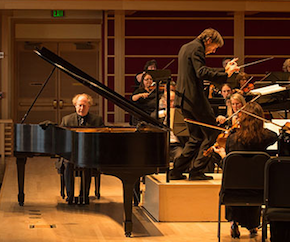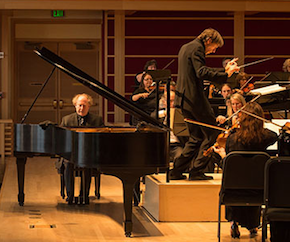
For its postseason concert on May 22, the Santa Rosa Symphony — together with piano soloist Jeffrey Kahane and conductor Bruno Ferrandis — played for free. The money will be used to benefit more than 20,000 children served by the Symphony's extensive outreach efforts, which include four youth orchestras, free concerts for elementary schoolchildren, and various school-based music activities. Over the years, these efforts have produced a steady stream of musicians and music lovers, a key factor in helping classical music thrive in the North Bay.
In a sign of the times, the concert began with a cell phone going off just as the orchestra was preparing to launch into Carl Maria von Weber's overture to his 1826 opera Oberon. Everyone paused while the guilty party silenced the device, and then the orchestra began anew, this time with a French horn instead of a cell phone. Conducting without a score, Ferrandis ushered the musicians through a spirited performance marked by many sudden transitions and a well-controlled rhythmic flexibility. The brass and basses were particularly strong, taking advantage of Weill Hall's superb acoustics to project a resonant tone.
True to its form, the overture set the stage for the main event: two beloved piano concertos by Beethoven (No. 3) and Chopin (No. 2) performed by conductor laureate Kahane, who led the Symphony from 1995 to 2006. He and Ferrandis seemed to read each other's minds throughout the concert, and they were never in conflict.
In the Beethoven, Ferrandis set a brisk tempo in the long introduction, crafting a tremendous buildup to the piano's eventual entry. Kahane picked up where the orchestra left off, playing his opening phrases with authority and utmost precision. He is a wonderful pianist to watch. His body language, while never extravagant, telegraphs full immersion in the music. One of his characteristic poses is to lean back during expressive passages, stare into space, and let his fingers glide across the keys. For more intense passages, he leans in, bearing down on the notes and then leaping off at the end of phrases.
The standing ovation from the nearly full house was immediate and sustained. "That was unbelievable," said my neighbor.
The opening movement is a classic example of motivic development, in which a short musical phrase is stated and restated in various guises. Kahane and Ferrandis highlighted that structure and creating a powerful sense of forward motion. The balance throughout was excellent, with Kahane's quietest passages fully audible and never drowned out.
That quietude dominated the Largo second movement, which was as dulcet as the first was forceful. Under Kahane's feathery touch notes flowed into each other, almost as if they hadn't been individually struck. The most dramatic passages were the quietest ones, perched just on the edge of evanescence.
In contrast, the finale was a boisterous Rondo that found Kahane hitting strong off-beat accents and sprinting through a cascade of runs. His energy was matched by the orchestra, which stayed with him beat for beat all the way to the rousing conclusion. "That was unbelievable," said my neighbor to his companion.
After intermission, that same neighbor advised his companion to "sit back and enjoy." He was referring to the Chopin Piano Concerto No. 2, a virtuosic showcase for the soloist, with the orchestra relegated to a minor role. Composed when Chopin was only 20, the concerto is filled with youthful enthusiasm and, in the second movement, heartfelt romantic longing.
Kahane proved indefatigable throughout. His light touch is one of his greatest strengths ... In Kahane's hands, the effect was otherworldly.
Kahane proved indefatigable throughout. His light touch is one of his greatest strengths, and he had plenty of opportunity to play at the softest of dynamics, with the orchestra barely audible in the background. He was at his softest in the languid second movement, with its dominant trills and operatic contours. Chopin intended the movement as an expression of his love for a young singer, and the yearning is evident, with one gentle shower of notes after another. In Kahane's hands, the effect was otherworldly, particularly in the middle section, where the piano line floats above a hushed string tremolo.
All is not sweetness and light, however. The outer movements have many driving passages, and Kahane attacked these vigorously. In the Allegro vivace finale, with its mazurka rhythms, his fingers went impossibly fast without ever missing a note. His interpretation emphasized happiness rather than drama, and he kept dancing all the way to the end, which was greeted with another standing ovation.
As the applause continued, Kahane settled down for an encore, Chopin's Nocturne in D flat. It was a fitting end for the concert, which began early in the evening with light streaming through Weill Hall's many windows and was now enveloped in darkness.

